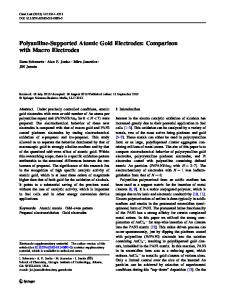High-performance three-dimensional nanoporous gold based electrodes for flexible all-solid-state supercapacitors
- PDF / 2,092,948 Bytes
- 9 Pages / 595.276 x 790.866 pts Page_size
- 34 Downloads / 305 Views
High-performance three-dimensional nanoporous gold based electrodes for flexible all-solid-state supercapacitors Yunqiang Yang1 · Jiali Zhang1 · Haixia Zhang1 · Ying Hou1 · Junjie Guo1
© Springer Science+Business Media, LLC, part of Springer Nature 2020
Abstract High-performance, flexible reduced graphene oxide (rGO)-polypyrrole (PPy)/nanoporous gold (NPG) electrodes are prepared by a facile electrochemical interfacial polymerization method using NPG as the substrate. Owing to the synergistic effect of three-dimensional (3D) porous architecture and superior electrical conductivity, the prepared electrode not only exhibits a good areal capacitance (232 mF/cm2), but also shows high volumetric capacitance (555.6 F/cm3). Hence, an all-solid-state supercapacitor assembled with rGO-PPy/NPG electrodes exhibits a high energy density of 238.8 mW h/cm3. Besides, this flexible supercapacitor also shows excellent cycling stability with retention of 91% with respect to the initial capacitance after 2000 galvanostatic charge–discharge cycles. This work offers a novel avenue for designing flexible supercapacitor. Keywords Nanoporous gold · Polypyrrole · Graphene · Flexible · Supercapacitor · Energy density
1 Introduction In recent decades, the development of the world economy depends heavily on the use of fossil fuels, such as coal, petroleum and natural gas [1]. The depletion of chemical fuel resources have triggered series of economic and social problems [2], which can be greatly eased by adopting new energy sources, including wind energy, hydropower, solar energy and geothermal energy [3, 4]. However, these new energies need to be converted into electricity for human utilization. Therefore, the development of high efficiency battery systems is particularly important [5, 6]. Among them, supercapacitor is expected to bridge the gap between conventional capacitors with high power density but low energy density and batteries that have high energy density Electronic supplementary material The online version of this article (doi:https://doi.org/10.1007/s10934-020-00908-x) contains supplementary material, which is available to authorized users. * Ying Hou [email protected] * Junjie Guo [email protected] 1
Key Laboratory of Interface Science and Engineering in Advanced Materials, Ministry of Education, Taiyuan University of Technology, Taiyuan 030024, China
but low power density [7]. Till now, two mechanisms have been reported for the charge storage of supercapacitors: the electrochemical double-layer capacitancitor (EDLC) by nonfaradic surface ion adsorption and the pseudocapacitor (PC) by fast faradic redox reactions at electrode/electrolyte interfaces [8]. Compared with batteries, supercapacitors have many advantages such as high power density, rapid charge/ discharge process, low cost and environmentally friendly [9, 10], which make them one of the most promising electrochemical storage systems, and thus are used in wide range of potential applications including, electric vehicles, medical electronics, public transp
Data Loading...











